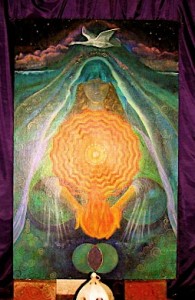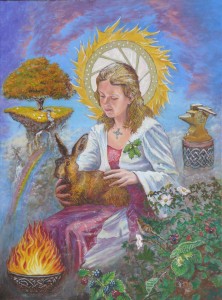Text from the folks of The White Spring in Glastonbury. And the image of Brigid below is from her altar in the White Spring.

Brigid, is a Celtic fire goddess, keeper of the hearth fire, of the fire in the forge, and of the Divine flame which burns in our hearts. Brigid is also a guardian of sacred springs and wells. Hence Her presence at the White Spring which is so greatly treasured.
The hazel tree and the swan are sacred to Brigid, the wolf her companion.
Brigid is the personification of the spiritual aspect of the natural impulse for new life. She is the spirit of Imbolc (Feb. 2nd), the first stirrings of spring. Call to her as midwife at the birth of new ways of being in your life and as godmother as they grow and flower.
Brigid is the inspiration of poets and prophets. She is the bridging and balancing energy that reveals the unifying principle between and above the experience of duality; between divine and human, tribe and land.
On a wonderful day around 525 c.e. a child filled with the spirit of the goddess Brigid was born in Ireland and was named Brigid, also called Bridie. Destined at birth to be a great saint. Her father was a druid chief named Dubtach, her mother Brocessa his Christian slave. Their love and the truth of their traditions met in the child. Brigid too willful to become a wife chose to enter a monastery. The bishop, prompted by the Holy Spirit blessed her as an Abbess as well as a nun. She lived and learned at the Beckery in Glastonbury before founding her abbey Cill Dara, the house under the oak, in Kildare Ireland. Here, women and men lived peaceful, prayerful lives together. It became famous for the art and craftsmanship created there, inspired by angels it was said. The abbey was a place of plenty, a place of learning and healing for all. Conleth, blacksmith and bishop, was the companion of Brigid there.
Brigid was greatly loved and known for her wisdom, good advice, hospitality and generosity. She inspired and transformed many people’s lives and performed great miracles of healing and of increase. A local king in return for healing gave her as much land as her cloak would cover she tossed it and five thousand acres fell under it. She hung her cloak on a sunbeam to dry. The land, the Burragh, is still protected.
Brigid is of the Mary sisterhood, called the Mary of Gael. She was midwife in the stable and godmother at the presentation in the temple. St Brigid’s day. Imbolc, the Celtic festival of the first stirrings of spring and the purification in the temple, are all celebrated on the 1st and 2nd of February.
Brigid is a real, living spirit amongst us.
Many of us, from many paths, have experienced her inspiration and transformation, her humour and wisdom, her help and healing hand in our lives.
Brigid is midwife as we give birth new ways of being, and stays with us as faery godmother as they flourish.
Call to her, she will hear you.

A BRIGID PRAYER
Inspire me, Brigid, sweet sister mine,
Bring healing to mind and body, soul and spirit.
May your flame of Divine love flow heart to heart.
Come, transform my life from within.
Inspire and heal and transform through me
So all may live in peace, justice and joy.
Brigid, we forever bless and honour thee.
Amen.
THE BRIGID FLAME
A candle flame or a burning fire is a universal symbol of the sacred. Many cultures, traditions and religions throughout history have held a perpetual flame. That means candle is lit from candle so the same flame endures, a fire is never allowed to grow cold. This is important in a number of ways. In the physical it ensures the community always has fire. Indeed it ensures the community endures, as a fire necessitates a fire keeper.
A fire elemental, a salamander, lives in the flame. As the flame grows years, centuries old the salamander matures into greater power. Angels and goddess’ may be connected through meditation with the flame. The divine energy radiated by the fire may be drawn into one’s heart and soul. Brigid’s flame was kept alight by her sisters for a thousand years spanning druid and Christian times.
As far as we know this flame was extinguished in 1220 by command of the bishop, other sources suggest it was lost in the reformation. For certain, it continued to burn in the astral realm. In 1807 the Brigidine order of sisters were reformed within the Roman Catholic church. In 1993 sisters of the order re-lit the Brigid flame and they hold it in their monastery in Kildare. It has become beacon for human rights.
Brigid is far more than a saint within the Roman church of course. Women and men from many paths and traditions are inspired by Brigid and many live a life of devotion to her in their own way. Gathering together on the 1st and 2nd February in Glastonbury has become quite a tradition. At this time in 2005 a fire was rekindled in Brigid’s name at the Beckery in Glastonbury in a ceremony honouring the spirit of the elements, the powers of nature and the Spirit of the land. A candle was lit from this fire and was held as a perpetual flame in first one and later a number of shrines. This flame is also held within the Brigid bower at the White Spring. Called the Brigid flame, as Brigid holds it so well, it is the flame of the universal cosmic consciousness, the fire of divine love.
The flame lights fires, some small, some immense at ceremonies and celebrations across the land. It lights the fire in the Brigid garden and that within the stone circle at Glastonbury festival and at other gatherings.
The flame is a living presence of the spirit of Brigid and a symbol of the divine love at the heart of a new community. A Celtic tribal way of life, an expression of Brigid’s inspiration, her love of justice, generosity and magical powers. Her deep connection with the earth and the wheel of the seasons. Held within it is a renewal of Brigid’s abbey inspired by the foundation in 6th century Ireland. The spirit of the wonderful woman at its head.
https://www.megalithicireland.com/St Brigid’s Well, Kildare.html
